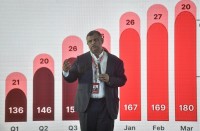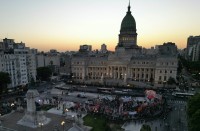
(Eagle News) — The headline inflation in the Philippines eased to 2.4 percent in August, from 2.7 percent in the previous month, bringing the year-to-date inflation for 2020 at 2.5 percent, according to the Philippine Statistics Authority (PSA).
Inflation in August last year was lower at 1.7 percent.
Malacanang immediately issued a statement saying that the easing of the inflation last month was a “positive development.”
-Gradual re-opening of economy leads to decrease in food prices-
“We credit this to the gradual re-opening of the economy, where we see a decrease in food prices,” Palace spokesperson Harry Roque said.
Roque said that “keeping the prices of basic commodities stable in this period of global health crisis and economic uncertainty remains our topmost priority.”
“This is in line with the vow of President Rodrigo Roa Duterte that no Filipino gets hungry amid the COVID-19 pandemic. We will therefore continue to monitor prices of basic goods and make sure there is unhampered flow in the movement and delivery of essential commodities to other places, notwithstanding the localized actions imposed in some areas,” he said.
Roque said that Malacanang is “also encouraged by data showing the agriculture sector’s resilience.”
He said that this “proved the effectiveness of President Duterte’s policies and programs for farmers and fisherfolks.”
“We will sustain these programs to boost agricultural production in the long-term,” Roque said in a statement.
-Commodity groups which posted lower inflation-
The PSA said that the “slowdown in inflation in August 2020 was primarily due to the deceleration in the inflation for the heavily-weighted food and non-alcoholic beverages which slid at an annual rate of 1.8 percent during the period, from 2.4 percent in the previous month.”
The PSA said that similarly, the indices of the following commodity groups posted lower inflation during the month:
Alcoholic beverages and tobacco, 17.7 percent;
Clothing and footwear, 1.9 percent;
Furnishing, household equipment and routine maintenance of the house, 3.9 percent;
Education, 0.1 percent; and
Restaurant and miscellaneous goods and services, 2.3 percent.
Contributing also to the deceleration in the overall inflation was recreation and culture whose index exhibited an annual decline of -0.1 percent during the period, from an annual gain of 1.1 percent in the previous month.
However, inflation for housing, water, electricity, gas, and other fuels slighlty went up by 0.9 percent, from 0.8 percent in the previous month. Retaining their previous month’s annual growth rates were health (2.8%), transport (6.3%), and communication (0.3%), the PSA data showed.
“Core inflation, which excludes selected food and energy items, slowed down to 3.1 percent in August 2020, from 3.3 percent in the previous month. Core inflation in August 2019 was recorded at 2.9 percent,” it said.
“For food, the annual rate at the national level eased further to 1.7 percent during the month, from 2.5 percent in July 2020. In August 2019, inflation for food was far lower at 0.3 percent,” the PSA release explained.
-Inflation in NCR at 2.2%, outside NCR at 2.5%-
Meanwhile, the Inflation in Metro Manila was posted at 2.2 percent in August. which was the same rate recorded in July. In August 2019, the inflation in the area was at 1.4 percent.
Outside Metro Manila, following the national trend, the inflation decelerated to 2.5 percent in August. In July, inflation in the area was observed at 2.9 percent, while in the same month in 2019, it was posted at 1.8 percent, the PSA said.
Over-all, by specific food item, the indices for rice and corn dropped by -1.1 percent and -0.6 percent, respectively. Similarly, the index for vegetables went down by -0.9 percent during August, from a 0.9 percent annual hike in July.
Annual mark-up for the index of oils and fats was higher at 2.4 percent in August.
“Likewise, the annual rate for sugar, jam, honey, chocolate and confectionery inched up to 0.1 percent. Meanwhile, annual rates of increments were slower in the indices of the remaining food groups,” the PSA data said.
(Eagle News Service)







